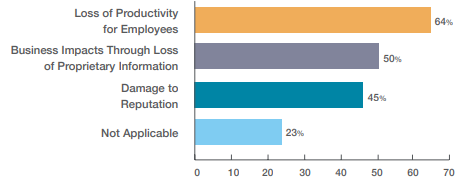Share this
Phishing Emails and Your Security: Research Details the Continued Risk
by Dan Stoy, Solutions Specialist // Managed Network Services on Sep 25, 2018 2:07:21 PM
“Phishing” lends itself to tongue-in-cheek humor and images, but it’s no laughing matter.
Cybercriminals continue to use phishing attacks to trick people into opening emails and/or clicking on links and files that allow malware (like ransomware) to breach your network security.
Phishing attacks continue because they work (for tips on how to avoid being hooked, read Some Day Your Nigerian Prince Will Come - 9 Simple Attempts to Dodge Phishing Emails).
In case you’re still one of those business leaders who think “not gonna happen to me,” here are some key stats from State of the Phish 2018, a research report from Wombat Security.
This survey of information security pros from around the world reveals that everyone needs to worry about phishing.
- 76% said they had at least one phishing attack in 2017 (the same as from 2016)
- 45% experienced phishing via phone calls and SMS/text messaging
- 3% experienced a USB-based social engineering attack (if you see a USB stick on the street, don’t pick it up!)
As for the overall rate of phishing attacks, an equal number -- 48% -- say that attacks are increasing or staying the same. A much small number paint a happier picture, 4% say rate of phishing attacks are decreasing.
In the actual good news category, click rates for phishing emails declined. That indicates a combination of software and user education is working. On the downside, cybercriminals are switching to more consumer-based email templates which fool users at a higher rate.
While that’s a good trend, there are three phishing templates that have an extraordinary high rate of success that you need to educate everyone in your office about:
- Online shopping security updates -- 86%
- Corporate voicemail from unknown caller -- 86%
- Corporate email improvements -- 89%
Two other types of emails sent as simulated attacks to gauge user response gathered a near 100% click rate -- a database password reset alert and an email that claimed to have an updated building evacuation plan.
The Impact and Cost of Phishing
Sadly, phishing does work. There was a rise in the three major impacts of successful phishing attacks from 2016 to 2017:
- Malware infection -- from 27% to 49%
- Compromised accounts -- from 17% to 38%
- Loss of data -- from 7% to 13%
The graphic below shows how companies measure the cost of phishing:

Phishing emails are increasing. Hopefully, next year’s research will reveal another dip in the overall success of these attacks. Do your part to prevent these attacks and protect your information, keep your network secure with updates and software patching and educate your users.
Share this
- December 2025 (1)
- June 2025 (1)
- March 2025 (1)
- February 2025 (1)
- January 2025 (4)
- October 2024 (1)
- July 2024 (1)
- June 2024 (4)
- May 2024 (4)
- April 2024 (4)
- March 2024 (5)
- February 2024 (4)
- January 2024 (4)
- December 2023 (1)
- November 2023 (4)
- October 2023 (4)
- September 2023 (4)
- August 2023 (4)
- July 2023 (4)
- June 2023 (5)
- April 2023 (2)
- March 2023 (1)
- February 2023 (2)
- January 2023 (2)
- May 2022 (1)
- April 2022 (3)
- March 2022 (1)
- February 2022 (1)
- December 2021 (2)
- October 2021 (2)
- July 2021 (1)
- June 2021 (1)
- April 2021 (2)
- March 2021 (2)
- February 2021 (1)
- January 2021 (2)
- December 2020 (1)
- November 2020 (1)
- October 2020 (2)
- August 2020 (2)
- July 2020 (2)
- June 2020 (2)
- May 2020 (1)
- April 2020 (2)
- March 2020 (4)
- February 2020 (4)
- January 2020 (4)
- December 2019 (3)
- November 2019 (5)
- October 2019 (3)
- September 2019 (4)
- August 2019 (3)
- April 2019 (4)
- March 2019 (2)
- February 2019 (3)
- January 2019 (4)
- December 2018 (4)
- November 2018 (7)
- October 2018 (5)
- September 2018 (10)
- August 2018 (7)
- July 2018 (5)
- June 2018 (8)
- May 2018 (10)
- April 2018 (10)
- March 2018 (7)
- February 2018 (6)
- January 2018 (8)
- December 2017 (7)
- November 2017 (8)
- October 2017 (7)
- September 2017 (7)
- August 2017 (7)
- July 2017 (3)
- June 2017 (5)
- September 2015 (1)
- June 2014 (1)


Comments (1)